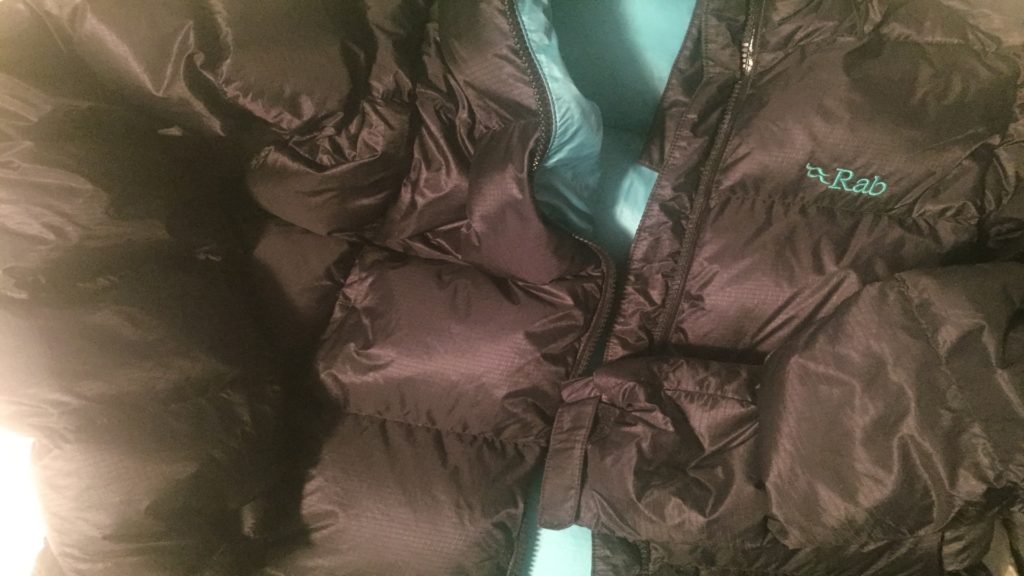This is the Denali coat, the Arctic coat, the one you couldn’t wear casually around town without roasting from the inside out. I bought mine, the women’s Rab Neutrino Pro, when I started to fall in love with climbing the Cascade volcanoes and needed to be able to tolerate temps near zero and realized that no amount of creative layering was going to do for me what an 800-fill goosedown parka would. Most hikes it stays home, but if I’m at altitude or it’s wintery, it’s in my pack. It might only come out on breaks and at the summit, but it becomes more of a safety issue than a comfort issue when temps dip—for some that’s into the teens, for me it’s closer to 30 if I’m not moving (we can blame my Southern California roots for that). This jacket is like wearing a sleeping bag, but with full mobility.
Terminology: Though there are some lightweight puffy coats, normally when one is referring to a “puffy,” they are referring to a parka of this caliber. Other terms include Puffy, Puffer, Big Puff, Floof, expedition coats, or down jackets.
Some things to look for in the fit of this piece are:
- A hemline that sits at least six inches below the top of your pants to avoid cold air getting up in from the bottom when you are reaching and bending
- A hood deep enough to go over a climbing helmet
- A high collar to protect your face even when the hood is down
- Drawcords on each side of the hood for when you need to pull it in tight to cover everything but your eyes
- Long enough sleeves that you don’t risk exposing your wrists between sleeve and glove. This was one of many reasons I went with my Rab—I have long arms and I get cold easily, and even with layers underneath, these cuffs come down past my wristbone. They are also tapered enough that I can fit them into the gauntlets of my mits
- As the final outer layer, your parka size should allow room for layers underneath
Other key features of a good mountain parka:
- Zip-up handwarmer pockets on both sides plus an interior pocket and a zippered chest pocket
- A waterproof two-way zipper that lets you adjust the fit at the bottom of the jacket as well as open the top for ventilation
- A DWR (durable water repellent) finish
- Adjustable/Velcro cuffs
If you are vegan or have allergies or are opposed to the use of animal product for human use, there are some great synthetic puffies out there that will keep you just as warm without all the feathers.
This is an investment along the lines of mountaineering boots or a 75L pack: a piece that won’t be used nearly as much as your other gear but is vital, that you’ll have for many seasons, and that can be quite costly. You’ll want to research parkas thoroughly, try several on, ask around, and take care of it with a little more attention than you would your other hiking clothes. To keep your puffy puffy, we recommend the following practices:
- Don’t wash down jackets in the washing machine; it ruins the down, it gets all clumped together
- Instead, surface-wash them with a sponge or damp washcloth
- Don’t put them in the dryer
- Instead, hang them over a chair or on a substantial hanger to dry
- Store indoors at room temperature
- Don’t leave your jacket in your pack overnight
- Re-waterproof as needed
Now that you’re ready to shop, here are some of the best in the industry to get you started:
- Rab Neutrino Pro Down Parka
- Arc’teryx Cerium LT Down Parka
- Patagonia FitzRoy Down Parka
- Feathered Friends Khumbu Down Parka
- The North Face Aconcagua Synthetic Parka

Wendy Harrington is a California native who has lived in a small town at the foothills of the Cascade Mountains in Washington state since 2001. Her love of trail running and peakbagging has led her to summit all five Washington volcanoes, climb to the high points of three states, and put nearly a thousand miles a year on her boots. Her loves include ridgelines, saddles, granite, one-day pushes on big mountains, anything volcanic, long solo days, and objectives that push limits and test endurance.

